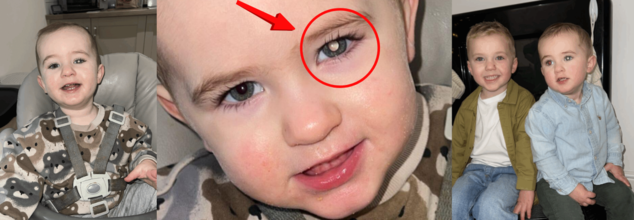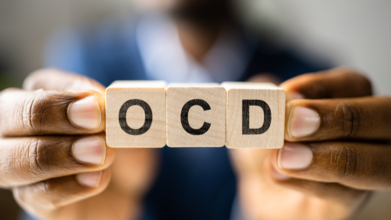- Health Conditions A-Z
- Health & Wellness
- Nutrition
- Fitness
- Health News
- Ayurveda
- Videos
- Medicine A-Z
- Parenting
- Web Stories
Parents Spot A Strange ‘Glow’ In Son’s Left Eye; A Googled ‘Home Test’ Confirmed Their Worst Fears

(Credit-The Childhood Eye Cancer Trust)
Shane, who had welcomed his second born son Kooper a year ago, noticed a strange glow in their child’s eye. Young Kooper’s parents, from Wales, explained that although after noticing this glow, they did not think much of it. They saw a white patch in their son’s eyes in low light, which prompted them to google the symptoms with one suggesting shining light directly into his eyes, which made the glow apparent! What they didn’t know at the time is that their son would soon be diagnosed with a rare form of cancer that affects kids under the age of six: Retinoblastoma.
Cancer is the leading cause of death in children and adolescents, it is one such disease that can unilaterally affect anyone, regardless of age, gender or any other factors. Every year more than 300,000 kids are diagnosed with cancer globally, according to the Indian Cancer society.
According to the American Cancer Society, Retinoblastoma is the most common type of eye cancer among children, it accounts for about 2% of all childhood cancer. However, it is a rare cancer affecting 3.3 cases per 1 million people under the age of 20
The World Health Organization (WHO) explains that 80% of children with cancer are cured, a surprising statistic showed that less than 30% of children are cured, in low- and middle-income countries (LMICs).
Unexpected Symptom Of Cancer
The Childhood Eye Cancer Trust (CHECT) emphasizes that common indicators of retinoblastoma include a white glow in the eye – which may only be visible under specific lighting conditions or in photographs – a squint, a change in the eye's appearance, or swelling of the eye.
Often, only a single symptom might be present. While a photo can reveal the tell-tale white glow, it's not always the case. Therefore, CHECT strongly advises seeking professional medical advice even if a photo doesn't show a glow but other symptoms are apparent.
Kooper’s Diagnosis And Initial Complications
Shane described the anxious period leading up to the diagnosis, "I noticed it on a Friday, and we decided to take him to the doctor first thing on Monday. The weekend was filled with panic, endless online searches, and imagining the worst – it was a terrifying experience. The doctor referred us to the local hospital a couple of days later, which was another unsettling time of uncertainty. We had read that there could be other reasons for the obscured red reflex in his eye, so we clung to the hope of a different diagnosis." The family had an appointment at Birmingham Women and Children's Hospital in December 2024.
Shane reflected on receiving the devastating news, "I don't think anything can truly prepare you to hear that your one-year-old has cancer, might lose his eye, or might never see out of it again – it was an incredibly emotional time. We immediately called our parents and used WhatsApp groups to inform the rest of the family. They had already suspected retinoblastoma after our initial hospital visit, so this was confirmation. We used the information provided at the hospital to reassure them and explain the treatment plan. The doctor discussed various chemotherapy options and also offered genetic testing, which we opted for, considering Kooper has an older brother and for Kooper's future and potential children."
Treatment for Retinoblastoma and Side Effects
Kooper has started receiving chemotherapy as the primary treatment for his retinoblastoma. His father, Shane, explained that the treatment plan has involved multiple approaches so far, including delivering chemotherapy drugs directly into an artery, using laser therapy, and administering chemotherapy via injections. The effectiveness of these different methods has varied.
A recent medical examination indicated that the main tumor in Kooper's eye had reduced in size. However, the doctors also noted the growth of smaller clusters of cancerous cells, known as spores, within his eye. Because of this, there's hope that the most recent treatment, the chemotherapy injection, will be successful in addressing this new development.
Shane also described a difficult side effect that Kooper experiences after each treatment session. For several days following his chemotherapy, when he is on steroid medication, Kooper becomes very distressed. This period of discomfort makes it impossible for his parents to send him to nursery, which is challenging as they both work. Despite these difficulties, Shane mentioned that Kooper surprisingly seems to enjoy his visits to the hospital.
What is Retinoblastoma?
According to The National Eye Institute retinoblastoma is a rare form of cancer that forms in the retina, it can cause blindness as well as can be life threatening. However, early diagnosis and treatment can help prevent vision loss as well as from spreading cancer
The most common thing parents notice with this eye cancer is that the black circle in the middle of their child's eye looks white when light shines on it. Often, this shows up in flash photos. The National Eye Institute explains that other symptoms include.
- Eyes that look crossed or one eye that wanders.
- An eye that looks sore, puffy, or red.
- Eyes that seem watery all the time.
- Not being able to see very well.
- Falling down more often.
- Bumping into things.
- Having trouble getting around the house.
- Holding toys and books very close to the face to see them better.
Microstress Is Real: These Tiny Terrors Are Quietly Wrecking Your Mental Health

We often associate stress with dramatic breakdowns, overwhelming work, or emotional turmoil. But what if the real danger lies in the tiny, everyday pressures we don’t even notice building up?
What Is Microstress and Why It Matters
“Stress is the most notorious yet underplayed disease,” says Alma Chopra, motivational speaker, disability rights activist and life coach. “It’s often thought of as an emotional onslaught that makes it difficult to function. But stress isn't just limited to our emotions; we can also become physically stressed from a chronic illness or an injury.”
Alma explains that microstresses are small, fleeting moments of stress that sneak into our daily routines. “Sometimes it creeps up through daily pressures until we hit our melting point. These are called microstresses,” she shares. These could include running late for a meeting or scrolling social media right after waking up. They may feel harmless in the moment but layer up to become chronic stress over time.
How Microstresses Mess With You
“These reactions feel minor and temporary, so they're quickly replaced by the next task or eased by a smiling face or a piece of cake,” says Alma. But the danger lies in how these minor stressors build up over time. “We tend to ignore these micro-stresses, but over time, they build low-level tension that will affect your sleep, focus, mood and health.”
Alma lists common microstressors and their effects:
- Alarm: “Jerks the body into a sudden state of alertness, disrupting natural rest.”
- Checking work email: “Doing this first thing in the morning puts us into a state of panic and anxiety.”
- Scrolling social media: “Overstimulates the brain and drains mental focus.”
- Confrontations: “Force us to deal with discomfort we’re not emotionally prepared for.”
- Unfinished tasks: “Juggling a long list without breaks builds pressure and leads to burnout.”
- Bruising your knee: “Even minor damage to the bone or soft tissue creates physical stress in the body.”
Alma advises recognising patterns and creating little routines to manage stress before it spirals. “Begin by recognising patterns, checking what drains you and creating little routines to relieve stress,” she says. “Start taking short breaks, creating boundaries and incorporating rejuvenating practices into your day.”
When Lifestyle Fuels Microstress
Sukirti Midha, spiritual wellness coach and founder of Sukh Yog, points out that microstress is a lifestyle issue. “Micro stress, as the name suggests, is small things we face as a working person or a householder. No gender age or designation we are discussing here; it’s the same for all,” she says.
According to Sukirti, “It’s in our lifestyle now; still, we are not aware of it.” She adds that people often don’t even feel it building up. “Do you think it happens overnight? No, nothing happens overnight except the sun comes out,” she jokes, adding a serious note that many people today don’t even see the sunrise, contributing to deficiencies like vitamin D.
Sukirti points out how society’s pressure to look good and maintain appearances feeds microstress. “When one gets conscious about looks, which include not only clothes but also touch-ups, make-up and hair. It’s not social pressure but created by us only.” She questions why people rely on external validation to feel good. “Why is it always important to look good to feel good?”
She also flags social media’s impact. “Many social media applications have filters to make you feel more beautiful and younger, which gives you plenty of stress when we look back in a basic mirror.” Comparing ourselves to others’ curated lives triggers a subtle but ongoing sense of inadequacy.
“Maintaining a status is a pressure these days,” she says. “Always remember as we shift from past to present or future to present, we learn happiness is about you & not the things or society status.”
The Simple Way Out
Both experts agree that while microstress can’t always be avoided, we can manage it better by slowing down, drawing boundaries and valuing simplicity. As Sukirti says, “Staying away from microstress isn’t easy, but preferring solace is an easy way out.”
Loving Perfection and Cleanliness Does Not Mean You Have OCD: Here Is What The Disorder Actually Means

If you have ever colour-coded your wardrobe, wiped the kitchen slabs repeatedly just because a speck of dust exists, or straightened a slightly off-centre painting on the wall, someone has probably laughed and said, I am so OCD too. But the thing is that you are probably not. And neither are they.
Somewhere along the way, we all misunderstood Obsessive Compulsive Disorder (OCD), a serious mental health condition, and casually said it. OCD has become shorthand for being neat, organised, or a lover of clean aesthetics. But as mental health professionals and those who actually live with OCD will tell you, that stereotype could not be further from the truth.
OCD is a clinically diagnosed anxiety disorder. It is not just about being extra clean or a control freak. It involves a cycle of obsessions, which are intrusive, unwanted thoughts and compulsions, which are repetitive behaviours or mental acts done to try to neutralise those thoughts.
Imagine being haunted by a constant fear that your loved one will die unless you tap the light switch exactly five times. Or being plagued by the thought that you have hit someone with your car, even though there is no evidence of it happening, and then going back to the same stretch of road again and again to check. That is the lived reality of OCD. It is not cute, it is not fun, and it definitely does not feel satisfying or neat.
The Cleanliness Myth
Yes, some people with OCD have cleanliness-related compulsions. But not everyone with OCD is a neat freak, and not all neat freaks have OCD. The need to wash your hands repeatedly until they are raw is not about loving cleanliness; it is about desperately trying to get rid of a feeling that something is terribly wrong. Often, the compulsion is not even rationally linked to the obsession. It is about trying to regain control over overwhelming anxiety, even if only temporarily.
In fact, OCD themes can be disturbingly varied, from fears of harming others to taboo thoughts to symmetry to morality. The common thing is that the thoughts are distressing, the anxiety is debilitating, and the rituals are exhausting.
Why It is Harmful To Mislabel Yourself As “OCD”
Calling yourself “OCD” because you like your stuff arranged by colour might seem harmless. But this kind of throwaway comment does a real disservice to people living with the actual condition. It trivialises their experiences and contributes to misinformation.
It also prevents those who might truly be struggling with OCD from recognising their symptoms and seeking help. Because if society keeps painting OCD as a personality problem, why would anyone think it is a serious problem?
What OCD Actually Feels Like
Ask anyone with OCD, and they will tell you it is not fun. It is not satisfying to double-check the lock for the 17th time. It is not enjoyable to feel like you are going to vomit because of a thought you did not ask for and cannot get rid of. It is a relentless loop of “what ifs” and “just in cases” that can take over your entire life.
OCD can interfere with relationships, work, sleep, and basic daily functioning. It is often accompanied by shame and secrecy because people worry others would not understand, or worse, will think they are dangerous or irrational.
Time To Rethink The Label
You might just be tidy. Or meticulous. Or even perfectionistic. And that is fine. But OCD? That is a diagnosis. A tough, often debilitating one that deserves respect. If you think you might actually have OCD, then help is available. Cognitive Behavioural Therapy (CBT), particularly Exposure and Response Prevention (ERP), has been proven to be effective. But it starts with understanding what OCD really is.
World IVF Day: What Makes The IVF Journey So Hard On The Mind?

In vitro fertilisation (IVF) is not just about science, syringes and success rates. What lies behind the walls of fertility clinics is a deeply personal journey filled with hope, heartbreak and resilience, making it more than just a medical procedure. Beyond the social taboos, infertility brings huge stress to the patients. And while IVF offers hope, it does not come easy. It is a rollercoaster ride that patients experience as they take on the road to this procedure; highs and lows can take a severe mental toll on them.
However, for those unversed, infertility has been classified by the World Health Organisation as a disease like diabetes or hypertension; the social taboo around it still persists. Over the years, advancements in reproductive science have made IVF treatments more patient-friendly and significantly improved outcomes. Yet, the focus often leans heavily on science, expertise and clinic proficiency, while the mental and emotional toll on the couple is overlooked.
For many, the psychological impact of IVF can match that of the death of a family member or going through a divorce. Although many people find IVF very stressful, every patient experiences it differently. Personalities and life experiences play a big role in determining how one handles the process and what part of IVF they find most difficult.
Why Is IVF So Emotionally Draining?
We ask an expert to break down several key factors that contribute to the immense stress IVF brings:
- Uncertainty of Outcomes
- Physical Strain
- Societal Pressure
- Guilt and Shame
- Depression After Failed Attempts
- Relationship Strain
Learning to Cope with Support Systems That Help
There is light at the end of the tunnel, and as Dr Saple says, there are several strategies that can help couples better cope with the IVF process.
- Psychological Counselling
- Support Groups
- Mind–Body Practices
Setting Realistic Expectations
“IVF may take more than one cycle to succeed,” she explains. Being mentally prepared for the outcome, while knowing you have done your best, helps couples accept results with resilience.
It is Okay to Ask for Help
As Dr Saple reminds us, mental and emotional health are as important as physical health during IVF. Prioritising emotional wellbeing not only makes the journey more bearable but can also improve the overall outcome. “Seeking help is a sign of strength, not weakness,” she says.
© 2024 Bennett, Coleman & Company Limited

